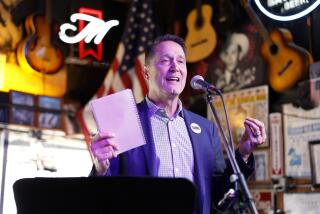Rdio pays artists to be its recruiters
Subscription music services offering unlimited access to a massive online jukebox have been around for more than a decade, but they’re still struggling to attract a mass audience. Meanwhile, some musicians complain that the likes of Spotify and Rhapsody pay such minuscule royalties, it’s counterproductive for artists to support them.
Now, one of those services -- Rdio -- is trying to solve both problems at once. On Tuesday it plans to launch a new payment system that gives money directly to artists for attracting new customers to the service.
Participating artists will receive $10 for every person they persuade to sign up for Rdio and remain on the service for more than a month. They’ll also receive free Rdio accounts and the tools to set up customized artist pages, enabling other users to see what they’re playing, the playlists they create and the music they recommend.
The move, which has been in the works for months, aligns the interests of artists and Rdio more tightly than any other subscription service, potentially separating Rdio from market leader Spotify and other rivals. It’s not likely to make any indie band’s bank account swell to match Kanye West’s, and some may wonder whether they’re getting a fair share of the benefit they’re bringing to Rdio. Nevertheless, it’s a new revenue stream for musicians at a time when recording artists need all they can get.
The idea for the payments comes from Rdio’s co-founder Janus Friis, whom musicians may remember as the co-founder of the Kazaa file-sharing network. The most popular of the original Napster’s successors, Kazaa helped turn illegal downloading into the mainstream activity it has become -- a development that the major labels and recording artists say caused CD sales to plummet.
“There is no art without artists,” Friis said in a news release, with no apparent hint of irony. “As part of this industry, we know a business that doesn’t reward its most important contributors is a business that has to change.”
It would be a mistake to see this as a personal gesture by Friis, however. Rdio is trying to make the leap from a niche product for music junkies -- people with such a voracious appetite for songs that they’re constantly on the lookout for something new -- to a product that appeals to people who don’t spend a lot of money on music. The artist-payment plan coincides with the company’s first big advertising blitz, which includes TV commercials and high-profile billboards.
Some artists have criticized the streaming services for paying too little for the music that they’re building their businesses on. The services typically pay a percentage of their monthly revenue to their music-industry partners -- the labels and unaffiliated artists -- based on the number of times that subscribers play the songs in each copyright holder’s catalog. That translates to a fraction of a penny per play.
Drew Larner, Rdio’s chief executive, said the problem for artists wasn’t the royalty rate as much as the limited popularity of the subscription services. With roughly 10 million or 11 million paying customers globally, there’s just not enough music being played to generate the kind of royalties that, say, Sirius XM can generate with its 25 million users, Larner said.
Larner argued that an artist who brings new customers to Rdio can benefit from more than just the one-time payment of $10 per head. Those fans are likely to play the lots of the artist’s music, Larner said, which would generate more royalties for the artist and his or her label.
The early participants include rapper Snoop Dogg, indie rock band Gold Motel and rocker Brendan Benson, whose Rdio page is shown above. Emily White, who manages Benson and Gold Motel, scoffed at the notion that Rdio’s new system wasn’t generous enough. Her artists are happy with the $10-per-head fee, she said, because “they’re so used being paid pennies and dollars.” She added that all of the artists she represents who are participating love Rdio, and “most would be recommending it anyway.”
With sales of recorded music far below their level in the years before file sharing, the challenge for musicians today is to find revenue wherever they can. “We’re competing with free,” White said. “So if we can derive revenue from a streaming platform, I’m all for it.” She added that the easy part is persuading hardcore fans to pay for an artist’s work. The bigger challenge is converting the casual listener into a paying customer, which is the direction Rdio is trying to go.
Casey Rae-Hunter, deputy director of the musicians advocacy group The Future of Music Coalition, said he’s all for new approaches that pay artists directly rather than funneling money into the “black hole” of major-record-label accounting. But he was still skeptical of Rdio’s offer, which he saw as mainly a public relations effort.
He argued that there’s a finite number of fans an artist can deliver to Rdio, so there’s only so much an artist can hope to make from the new system. But those customers can deliver far more in value to the service than Rdio will ever pay to the artist who recruited them, Rae-Hunter said.
“Just because you’re underpaying artists,” he said, “doesn’t mean you’re making up for it by having them be your best marketers.”
ALSO:IPad Mini rumor mill: Production has started in Brazil
Facebook’s Sheryl Sandberg pitches Wall Street, Madison Ave.
Google this: Search giant is second-most valuable tech company
Jon Healey writes editorials for The Times. Follow him on Twitter @jcahealey
More to Read
Inside the business of entertainment
The Wide Shot brings you news, analysis and insights on everything from streaming wars to production — and what it all means for the future.
You may occasionally receive promotional content from the Los Angeles Times.











